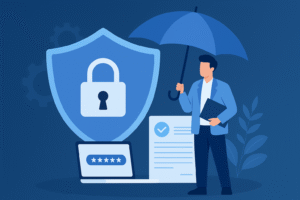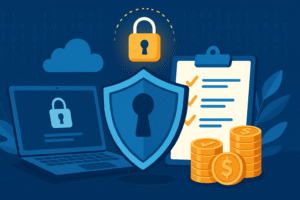No Cyber Insurance Risks: What Every Business Needs to Know
Introduction
In today’s digitally driven world, cyber threats aren’t just looming they’re actively targeting businesses of all sizes. From mom-and-pop shops to multinational corporations, cybercrime is the new business pandemic, and it’s evolving faster than ever.
So, what happens if you don’t have cyber insurance?
In this post, we’ll break down the costly, legal, operational, and reputational dangers of going without cyber insurance. You’ll get real examples, key facts, personal tips, and a clear understanding of why skipping cyber coverage is a high-risk gamble you simply can’t afford.
🌐 The Rising Threat of Cyber Attacks
Cybercriminals aren’t targeting only big tech anymore. Small businesses are now a prime target due to their often weaker cybersecurity infrastructure. Phishing scams, ransomware, and unauthorized access attempts are daily occurrences and they’re getting more sophisticated.
“Cybercrime will cost the world $10.5 trillion annually by 2025.” – Cybersecurity Ventures
🛡️ Why Cyber Insurance Matters Today
Cyber insurance helps mitigate these threats by covering recovery costs, legal liabilities, and reputation management. Without it, a cyberattack doesn’t just hit your network it can shut your business down.
1. Financial Impact of Data Breaches
📉 Cost of a Single Breach
A data breach can instantly disrupt your operations. Whether it’s stolen financial records or leaked customer data, the average cost of a breach in 2024 is $4.45 million, according to IBM.
Even a minor breach may trigger:
-
Emergency IT services
-
Customer notification and identity protection
-
Legal consultations
-
PR crisis management
Average Data Breach Costs by Company Size
🚫 Lack of Coverage Consequences
Without cyber insurance, you pay everything out of pocket. That means draining your capital reserves or halting operations entirely.
Always calculate your breach exposure during annual risk assessments. If that number scares you, insurance is a must-have.
2. Ransomware Attack Costs
💸 Payout Demands and Negotiations
Ransomware is one of the most financially devastating cyber threats. Attackers lock your files and demand thousands — often millions in cryptocurrency.
“In 2023, 66% of organizations were hit by ransomware, with average payouts reaching $1.54 million.” – Sophos State of Ransomware Report
Ransomware Attack Cost Breakdown
Total
🔓 Recovery Without Insurance
Without insurance, you’re alone in deciding whether to pay or not. You’ll also cover the cost of:
-
Ransom negotiations
-
Data restoration
-
Post-incident monitoring
Even if you don’t pay, recovery costs are still massive. Cyber insurance typically covers both negotiations and technical restoration.
3. Cyber Extortion Threats
👤 Nature of Cyber Extortion
Cyber extortion involves threats to release sensitive data unless payment is made. Unlike ransomware, data might already be exfiltrated.
Common threats include:
-
Releasing confidential employee data
-
Publishing client contracts
-
Exposing intellectual property
⚖️ Legal and Financial Risks
If you can’t pay or stop the release, the legal fallout could be worse. Lawsuits from affected parties, regulatory probes, and class-action suits can follow.
Have a data classification policy in place and ensure your insurance covers extortion scenarios.
4. Business Interruption Losses
⏳ Downtime and Lost Revenue
A breach could bring your entire system down. For e-commerce stores, that means zero revenue during downtime. For healthcare or finance firms, it can be life-altering or criminally negligent.
A recent study showed that every minute of IT downtime costs businesses $9,000 on average.
IT Downtime Revenue Impact Analysis
Based on $9,000 per minute industry average
| Downtime Period | Revenue Loss | Impact Scale |
|---|---|---|
| 1 Minute | $9,000 | |
| 1 Hour | $540,000 | |
| 1 Day | $12.96 Million | |
| 3 Days | $38.88 Million | |
| 1 Week | $90.72 Million |
🚧 Recovery Without Support
Insurance typically covers lost income, vendor costs, and expedited tech fixes. Without it, you’re delayed, unprotected, and financially bleeding.
Know your Recovery Time Objective (RTO) how long can you be offline before you’re in real trouble?
5. Regulatory Compliance Penalties
📜 Breach Notification Laws
Under laws like GDPR, CCPA, and HIPAA, you must notify affected parties — and fast. Failing to comply means heavy fines.
GDPR fines exceeded €2.92 billion in 2023 alone, with over 300 data breaches reported weekly.
💥 Fines Without Insurance Backing
Cyber insurance often absorbs the cost of these fines and ensures you’re compliant. Without it, you’ll pay legal fees and penalties directly.
Map your data flows and legal obligations yearly, then check your cyber policy to see what’s covered.
6. Digital Asset Protection
🧾 What Assets Are at Risk?
Digital assets include:
-
Customer databases
-
Intellectual property
-
E-commerce platforms
-
Cloud storage
-
Proprietary software
Losing these can destroy competitive advantage or stall product delivery.
🛠️ Insurance Coverage for Digital Assets
Cyber policies protect these assets by covering:
-
Data recovery
-
Restoration of software
-
Equipment replacement
Keep an inventory of digital assets and ensure backups are part of your disaster recovery plan.
7. Network Security Breach Fallout
🕳️ Common Network Vulnerabilities
Even small flaws can be exploited. Think outdated software, weak passwords, or unsecured endpoints.
-
92% of malware is delivered by email
Attack Vector Flowchart Common Attack Vector PathEMAIL ENTRYPhishing
Malware
Attachments→NETWORK BREACHLateral
Movement
Privilege Escalation→SYSTEM DAMAGEData Theft
Ransomware
Downtime© 100khits.com
-
60% of SMBs go out of business within 6 months of a breach
❌ Consequences Without Policy Support
No policy = no help. You’re forced to:
-
Hire emergency IT
-
Patch and audit systems manually
-
Absorb customer churn
Run regular network penetration tests and have an IRP (Incident Response Plan) linked to insurance clauses.
8. Legal Liability and Lawsuits
👥 Lawsuits from Clients or Partners
When client data is compromised, you’re liable. That can mean breach of contract, negligence, or even fraud claims.
Litigation costs add up quickly, including:
-
Legal representation
-
Settlement payouts
-
Damages awarded in court
💼 Court Costs Without Cyber Coverage
Cyber insurance includes legal defense and settlement costs. Without it? You may be forced to shut down just to avoid bankruptcy.
Review third-party liability inclusions in your policy, especially if you handle sensitive partner data.
9. Damage to Reputation and Brand
🧠 Trust Erosion After Attacks
Would you trust a business that leaks your personal data? Exactly. Public perception plummets after a breach, especially if it’s mismanaged.
“75% of customers will stop doing business with a company that suffers a data breach.” CISCO Data Privacy Benchmark
📢 Recovery Costs Without Insurance
Cyber insurance typically provides:
-
PR crisis management
-
Customer identity protection
-
Reputation repair
Without it, you’ll fund costly campaigns and incentives to win trust back.
Prepare breach communications templates in advance you won’t have time when it happens.
10. Incident Response and Forensics Costs
🧾 The Price of Investigation
After a breach, you need to:
-
Trace how it happened
-
Identify affected parties
-
Document everything for legal and regulatory review
Forensics experts charge $250–$500 per hour, and the process takes weeks.
🔒 Limited Options Without Insurance
Cyber policies cover forensic analysis, breach investigation, and regulatory documentation. Without it, you’re stuck navigating technical chaos alone.
Build a relationship with a trusted cybersecurity firm preferably one accepted by your insurer.
✅ Conclusion
If you’re still wondering whether cyber insurance is worth it, ask yourself this:
Can your business afford millions in damages, regulatory penalties, and brand collapse?
The answer is probably no.
No cyber insurance risks are too steep to ignore. As threats rise and regulations tighten, cyber insurance isn’t a luxury it’s a vital layer of business protection. Don’t wait for a breach to regret not having it.
The True Cost of No Cyber Insurance
What Every Business Needs to Know About Cyber Risk Exposure
Recovery Timeline Without Insurance
The Hidden Costs of Going Uninsured
❓ Frequently Asked Questions (FAQs)
1. Is cyber insurance necessary for small businesses?
Yes! Small businesses are actually more likely to be targeted due to their weaker security.
2. What does cyber insurance cover?
It typically includes data breach recovery, legal liability, ransomware payouts, PR management, and forensic analysis.
3. How much does cyber insurance cost?
Costs vary, but most small businesses pay between $1,000 to $7,500 per year, depending on risk level.
4. Can I get cyber insurance after a breach?
You can, but it won’t cover past incidents. It’s like buying car insurance after an accident — too late.
5. What industries need cyber insurance the most?
Healthcare, finance, e-commerce, legal, and education sectors face the highest cyber risks.








